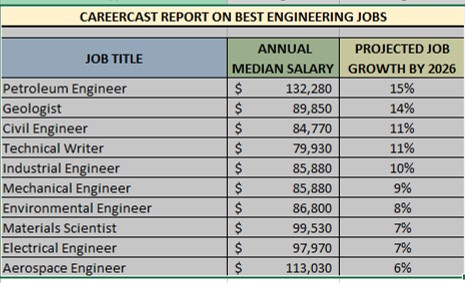
You have come to the right spot if your goal is to become an electric engineer. You must decide what career path you want before you can take the next step. CareerExplorer allows you to take a free career test. The results have been described as "shockingly accurate" by users.
High school diploma
You do not need a highschool diploma to be an electrical engineer. A bachelor's degree is required for most jobs in this field. Some employers may also accept practical experience. You can discuss your plans with a guidance counselor to help you decide which courses to take. Electrical engineers should study math and physics, particularly those related to electricity. To build a solid foundation in mathematics and physics, electrical engineers must also take chemistry.

Aspiring engineers in electrical engineering can seek work in various industries from automotive to medical. After graduating from college, they can advance their careers to other aspects of electrical engineering. Some jobs in electrical engineering require a high-school diploma. There are many career options for those who graduate from this field. It requires hands on experience, problem-solving skills and multidisciplinary teamwork. If you are determined, you can realize your dreams.
Dual enrollment programs
Dual enrollment for electrical engineers allows students the opportunity to double majors in two programs. This allows them both to receive two degrees at once. Students must satisfy all requirements of both programs. This includes completing an application and submitting high school transcripts. A parent or guidance counselor must sign the application. Once a student has applied, they are contacted by the LELWD and given an interview. Successful applicants will then need to complete their college applications.
Students interested in the dual enrollment program for electrical engineers will begin by taking foundational courses in computer and engineering. These courses will give students an overview of all the degree options as well as basic skills. Students are taught the fundamentals and practical skills of electrical engineering. They also learn how to use hardware tools in many labs. These concepts are then applied during capstone and freshman designs. Students interested in dual majoring in computer and electrical engineering can take dual programs, elective courses, or a concentration in one of these fields.
Wearable wireless technology
Wearable electronics are a hot area in the technology sector. Wearable electronics, such as smart watches, fitness trackers and other wearable devices, are in great demand. The technology is essentially an aesthetically pleasing pedometer. Researchers are working to lower the power consumption of wearable electronics and create a low-power computing system. This technology can be used to power other devices, and it will also help users stay in touch with their loved ones.

A wearable device can detect any changes in a person’s health that need to be treated. An example of this is the LiveNet system from MIT's Media Laboratory. The device can measure ECG and EMG as well as galvanic skin conductance. Researchers are testing the device in Parkinsonian patients and those with epileptic seizure. Another wearable device, LifeGuard, was designed to monitor health conditions in extreme environments and has undergone extensive testing. A recent study also included wearables.
FAQ
What is the Most Hardest Engineering Major?
Computer science is the most challenging engineering field because you have learn everything from scratch. You must also know how to think creatively.
Programming languages such as C++, JavaScript and PHP will be required to comprehend.
It is also important to understand how computers work. You will need to know about hardware, software architectures and operating systems.
Computer Science is a good choice if you're looking to be an engineer.
What kinds of jobs are available if I am an engineer?
Engineers can find employment in almost every industry, including manufacturing, transportation, energy, communications, healthcare, finance, government, education, and defense.
Engineers who specialize in particular fields can often find employment at specific companies or organizations.
For example, electrical engineers may work for telecommunications companies, medical device manufacturers, or computer chip makers.
Software developers could be employed by websites or mobile apps developers.
Computer programmers may work for tech firms like Google, Microsoft, Apple, Amazon, Facebook, or IBM.
What are civil engineers doing?
Civil engineering deals with the construction and design of large-scale structures, such as bridges, roads, buildings, dams and tunnels. It covers all aspects of structural engineering, including building materials, foundations, geotechnics, hydraulics, soils, environmental impact assessment, safety analysis, and traffic management. Civil engineers ensure that your project is both cost-effective, and environmentally responsible. They must make sure that the structure lasts.
They may also be involved in the planning and implementation of public works programs. For example, they may be responsible for the construction or design of a bridge, road, or tunnel.
Statistics
- 8% Civil engineers solve infrastructure problems. (snhu.edu)
- Job growth outlook through 2030: 9% (snhu.edu)
External Links
How To
How to make Engineering Drawings: Letter Writing
There are two types of engineering drawings: architectural drawings and engineering sketches. The first type describes the product's physical features, while the second one shows how the product should look. Both types include detailed specifications, dimensions, symbols, text, and arrows. Engineers will use their own language to write these documents. They can refer to specific units or abbreviations as well as acronyms. These terms are called engineering lingo. This article will explain what these terms mean.
A letter refers to a formal document sent by an individual/organization to another person/organization. A standard letter includes a salutation, signature and date. Most people also include a self-introduction at the beginning of the letter. Some letters might contain business details such as legal agreements. Others might contain greetings and signatures.
Engineers draw diagrams and create plans using their professional experience. To communicate this work effectively, engineers must use precise language. Technical terms refer to the product, process or materials used and their methods.
Engineers often use special terms to explain things. They use the term "ampere" for electrical current. For mass measurement, they might use "kilograms per meter squared". These terms are called scientific numbers. Because they are frequently used, engineers refer to them as common names. Common names can be easier to remember and understand.
Abbreviations are used frequently for technical terms. A abbreviation is a shorter word. Example: "kW" means kilowatt. The term "KW" is a kilowatt. You don't have to memorize the full name.
Engineers use many other acronyms and abbreviations in addition to technical terms. These are similar to abbreviations, but they are composed of multiple words. You can find examples such as "IEC," DIN, and "ANSI." These are essential because they facilitate communication and make it easier.
Engineers do not always use the same spelling rules as others when they use their jargon. They may spell out numbers using digits instead number. They might use different capitalizations to normal. Capitalization refers if a word begins with a capital letter (or lowercase). Words beginning with vowels sound differently are spelled than words that begin using consonants.